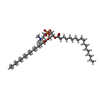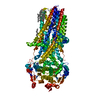+Search query
-Structure paper
| Title | Structural basis for CFTR inhibition by CFTR-172. |
|---|---|
| Journal, issue, pages | Proc Natl Acad Sci U S A, Vol. 121, Issue 10, Page e2316675121, Year 2024 |
| Publish date | Mar 5, 2024 |
 Authors Authors | Paul G Young / Jesper Levring / Karol Fiedorczuk / Scott C Blanchard / Jue Chen /  |
| PubMed Abstract | The cystic fibrosis transmembrane conductance regulator (CFTR) is an anion channel that regulates electrolyte and fluid balance in epithelial tissues. While activation of CFTR is vital to treating ...The cystic fibrosis transmembrane conductance regulator (CFTR) is an anion channel that regulates electrolyte and fluid balance in epithelial tissues. While activation of CFTR is vital to treating cystic fibrosis, selective inhibition of CFTR is a potential therapeutic strategy for secretory diarrhea and autosomal dominant polycystic kidney disease. Although several CFTR inhibitors have been developed by high-throughput screening, their modes of action remain elusive. In this study, we determined the structure of CFTR in complex with the inhibitor CFTR-172 to an overall resolution of 2.7 Å by cryogenic electron microscopy. We observe that CFTR-172 binds inside the pore near transmembrane helix 8, a critical structural element that links adenosine triphosphate hydrolysis with channel gating. Binding of CFTR-172 stabilizes a conformation in which the chloride selectivity filter is collapsed, and the pore is blocked from the extracellular side of the membrane. Single-molecule fluorescence resonance energy transfer experiments indicate that CFTR-172 inhibits channel gating without compromising nucleotide-binding domain dimerization. Together, these data reconcile previous biophysical observations and provide a molecular basis for the activity of this widely used CFTR inhibitor. |
 External links External links |  Proc Natl Acad Sci U S A / Proc Natl Acad Sci U S A /  PubMed:38422021 / PubMed:38422021 /  PubMed Central PubMed Central |
| Methods | EM (single particle) |
| Resolution | 2.7 Å |
| Structure data | EMDB-42101, PDB-8ubr: |
| Chemicals |  ChemComp-MG:  ChemComp-ATP:  ChemComp-LBN:  ChemComp-CLR: 
ChemComp-WG5:  ChemComp-HOH: |
| Source |
|
 Keywords Keywords |  MEMBRANE PROTEIN / Inhibitor / MEMBRANE PROTEIN / Inhibitor /  CFTR CFTR |
 Movie
Movie Controller
Controller Structure viewers
Structure viewers About Yorodumi Papers
About Yorodumi Papers






